April 14 update on COVID-19 in MN: Vaccinations slow amid Johnson and Johnson 'pause'

Go Deeper.
Create an account or log in to save stories.
Like this?
Thanks for liking this story! We have added it to a list of your favorite stories.
3 things to know
Walz says national pause in J&J vaccine out of “abundance of caution,” won’t substantially affect Minnesota vaccination effort
About 48 percent of adults with at least one vaccine dose, but vaccination rates aren’t likely to accelerate in the next week
Hospital admissions, active caseload trends hovering at winter levels; health officials say virus variants likely are driving increase in new cases
Updated: 4:27 p.m.
Minnesota’s vaccination rate remains near a record high, with around 37,000 new first doses being administered per day. But the number of new doses shipped into the state has fallen sharply recently — especially fewer doses of the one-shot Johnson & Johnson vaccine.
On Tuesday, state officials followed the lead of the federal Food and Drug Administration and Centers for Disease Control and Prevention, which jointly recommended a pause in administering the one-dose Johnson & Johnson vaccine. Minnesota will receive no new Johnson & Johnson doses next week, a sharp drop from the 80,000 it received last week.
Here are Minnesota’s current COVID-19 statistics:
6,978 deaths (16 new); 547,101 positive cases; 95 percent off isolation
48 percent of adults with at least one dose; 33 percent completely vaccinated
About 84 percent of Minnesotans 65 and older with at least one vaccine
“This is being done out of an abundance of caution. This is the way the system is supposed to work. I would anticipate this should be a relatively short pause,” Gov. Tim Walz said Tuesday, adding that 95 percent of the vaccinations in Minnesota have been Pfizer or Moderna supplies and those shipments are continuing unabated.
Turn Up Your Support
MPR News helps you turn down the noise and build shared understanding. Turn up your support for this public resource and keep trusted journalism accessible to all.
Walz, former Gov. Tim Pawlenty and Health Commissioner Jan Malcolm all received the J&J vaccine two weeks ago.
Severe side effects from the J&J vaccine remain extremely rare, said Malcolm. Anyone experiencing severe headaches, abdominal pain or shortness of breath within three weeks of receiving the J&J shot should contact their health care provider, she said.
Officials say they are not aware of any cases of blood clots occurring among the more than 184,000 state residents who have received the single dose vaccine.

Vaccination rates probably won’t accelerate any time soon. Minnesota is on tap to receive about 142,000 new first doses next week — about the same number it received this week. That’s enough to vaccinate about 20,000 new people per day, on average. Before the J&J pause and an earlier factory mishap, officials had been hopeful that a flood of new J&J vaccines would combine with existing Pfizer and Moderna vaccines to drive Minnesota’s vaccination rate to a new level.
Vaccinations, cases, ICU needs push higher
The newest numbers still suggest the state may reach a hopeful milestone — half of adults with at least one vaccine dose — by the end of this week or early next.
About 33.1 percent of Minnesota adults are completely vaccinated; 48.3 percent have received at least one vaccine dose, including about 84.4 percent of residents age 65 and older, the state Health Department said Wednesday.
But COVID-19 case counts are trending higher, too. Two weeks ago, the state was averaging about 1,600 new cases per day. Now, it’s about 2,100.
The number of known, active cases has been trending upward over the past few weeks, with more than 17,000 as of Wednesday’s report — marking more than three weeks with active daily counts above 10,000.
Hospitalizations have climbed significantly in the past weeks to levels not seen since January, and deaths tied to the disease are trending up, too. Health officials say coronavirus variants circulating in Minnesota are driving those increases.
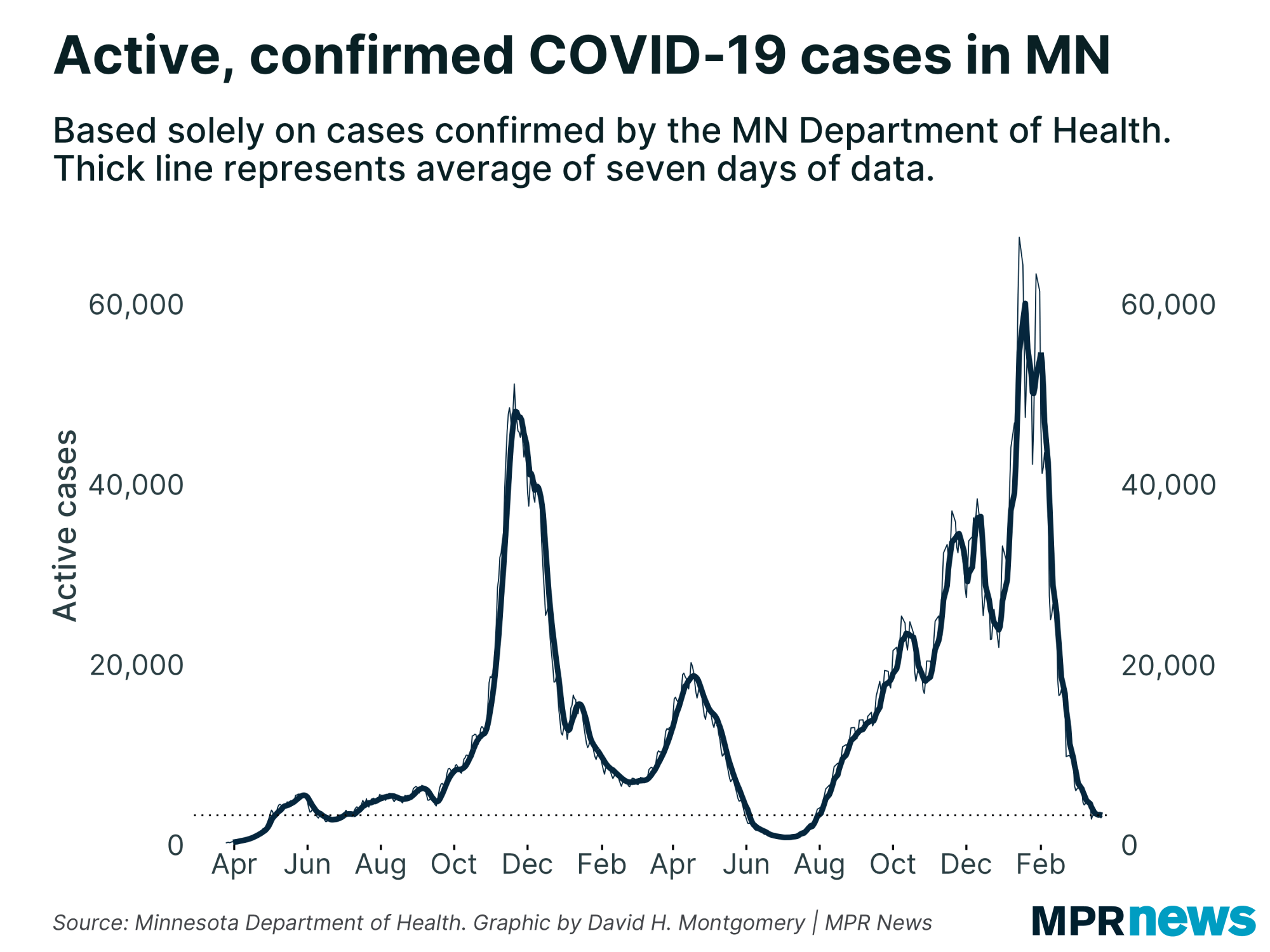
The state on Wednesday reported 681 people in Minnesota hospitals with COVID-19; 164 needed intensive care, hovering near the highest number of ICU patients since early January.
While still low compared to late November and early December, the rising trend is notable given the worries over the rise of the highly contagious U.K. COVID-19 variant, which state health officials suspect is driving the current upswing.
To date, the state has confirmed at least 1,600 cases of the U.K. strain. State epidemiologist Dr. Ruth Lynfield said last week that the variant is linked to five deaths here and likely responsible for the majority of the spread happening now.
Malcolm said recently that while the increase in cases is concerning, the growing number of vaccinated people in Minnesota means the state likely won’t see as steep a surge in cases of the scope seen in November and December.
Three deaths reported on Wednesday raised Minnesota’s overall pandemic death toll to 6,978. Among those who’ve died, about 62 percent had been living in long-term care or assisted living facilities; most had underlying health problems.

The state has recorded 547,101 total confirmed or probable cases so far in the pandemic, including 1,715 posted Wednesday. About 95 percent of Minnesotans known to be infected with COVID-19 in the pandemic have recovered to the point where they no longer need to be isolated.
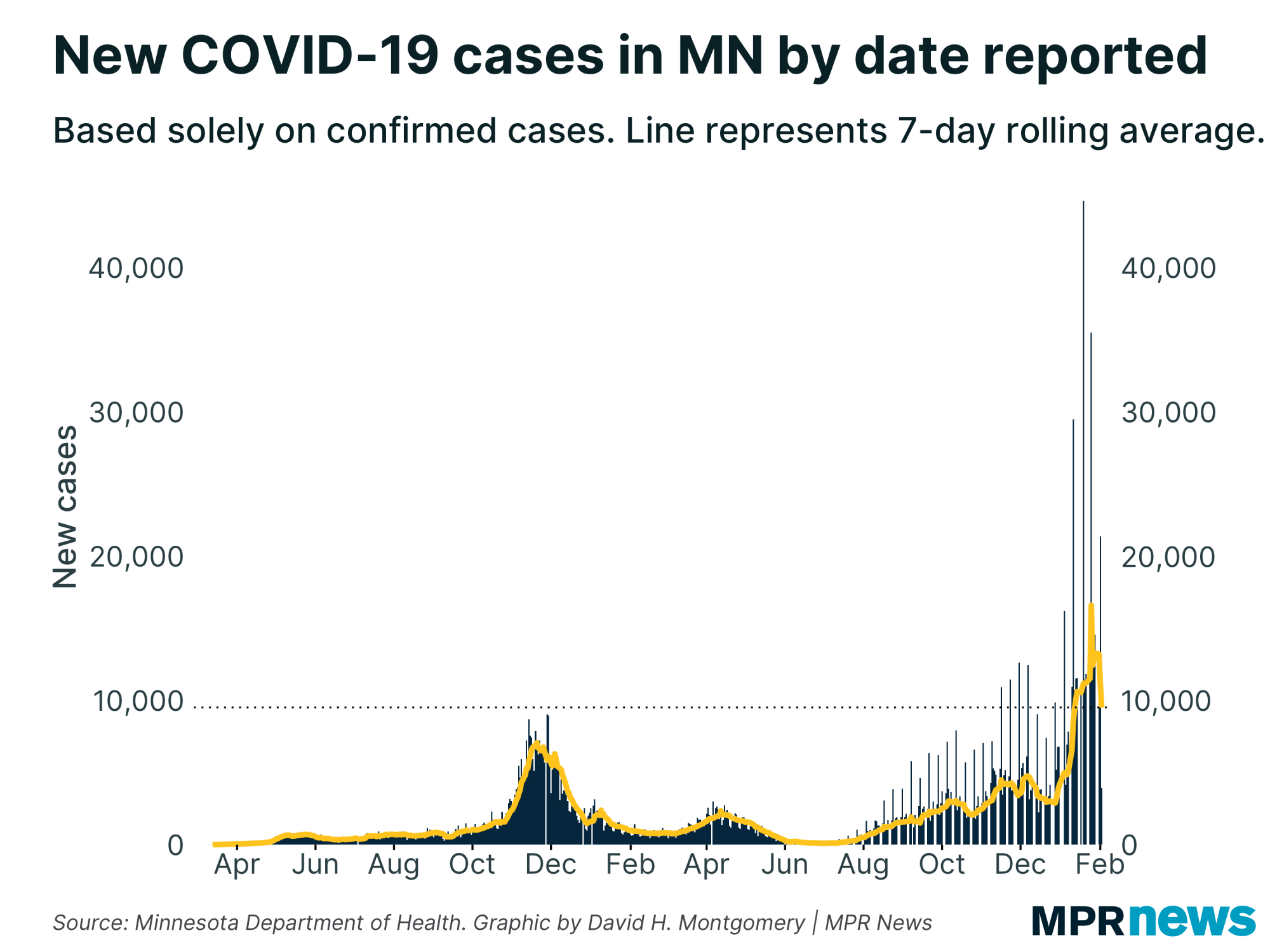
Regional hot spots bubble
Regionally, all parts of Minnesota are in better shape than they were in late November and early December. The latest numbers, however, show cases creeping up across the state.
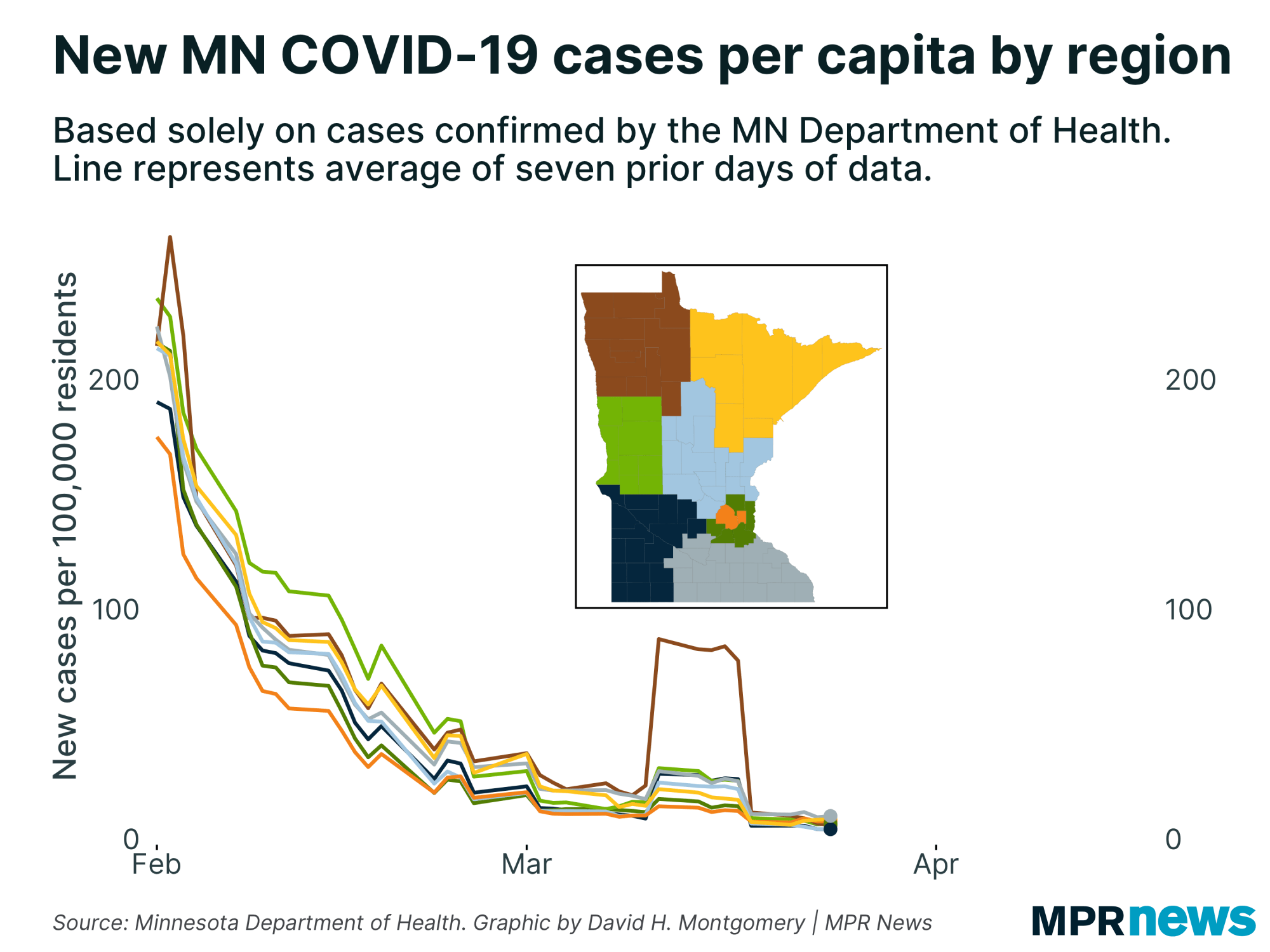
Public health leaders continue to keep watch on clusters popping up over in recent weeks in the southwest Twin Cities metro area as well as Mankato in southern Minnesota, in central Minnesota and around Aurora and Ely in the northeast.
On Monday, the state reported a new outbreak associated with a youth wrestling tournament. The state has linked at least 16 cases to the Northland Youth Wrestling Association State Wrestling Tournament in Sioux Falls, S.D., between March 31 and April 3.
The tournament drew 2,000 wrestlers in addition to spectators and Minnesota health officials say there was lax masking and social distancing at the event.
Nine counties, including Cass, Le Sueur, Lyon, Morrison, Murray, Rice, Todd, Wright and Yellow Medicine have confirmed cases. Eight schools in these regions have cases associated with the event.
State officials are asking that any students or families that attended the event be tested immediately, and to avoid all unnecessary travel.
Cases spread across age groups
People in their 20s still make up the age bracket with the state’s largest number of confirmed cases — more than 101,000 since the pandemic began, including more than 53,000 among those ages 20 to 24.
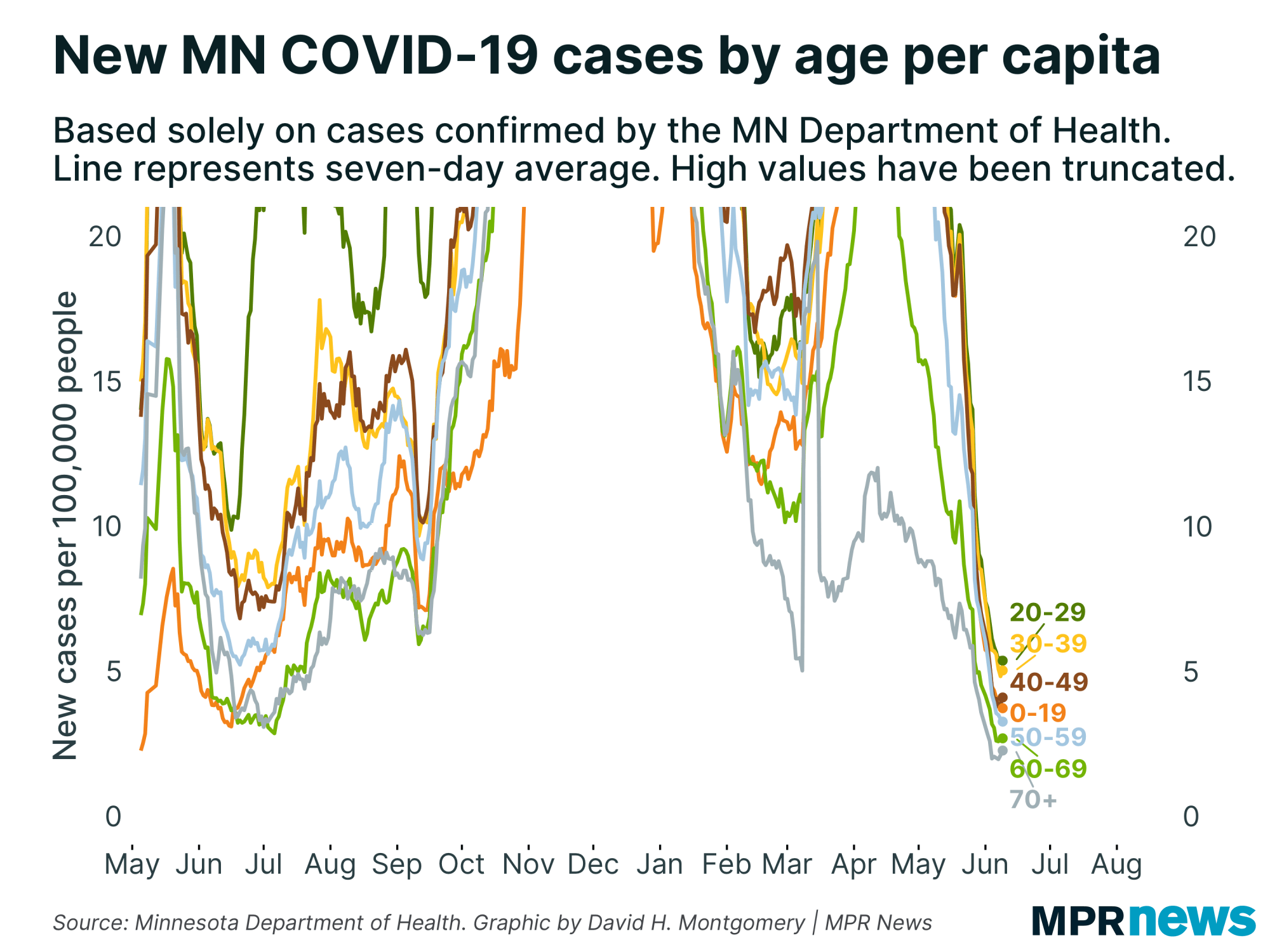
The number of high school-age youth confirmed with the disease has also grown, with more than 43,000 total cases among those ages 15 to 19 since the pandemic began.
With kids increasingly returning to school buildings and sports, Minnesota public health officials are urging Minnesota families with children to get tested every two weeks for COVID-19 until the end of the school year.
Although young people are less likely to feel the worst effects of the disease and end up hospitalized, experts worry they will spread it unknowingly to older relatives and members of other vulnerable populations. Those with the coronavirus can spread it when they don’t have symptoms.
Caseloads among people of color
In Minnesota and across the country, COVID-19 has hit communities of color disproportionately hard in both cases and deaths. That’s been especially true for Minnesotans of Hispanic descent for much of the pandemic.
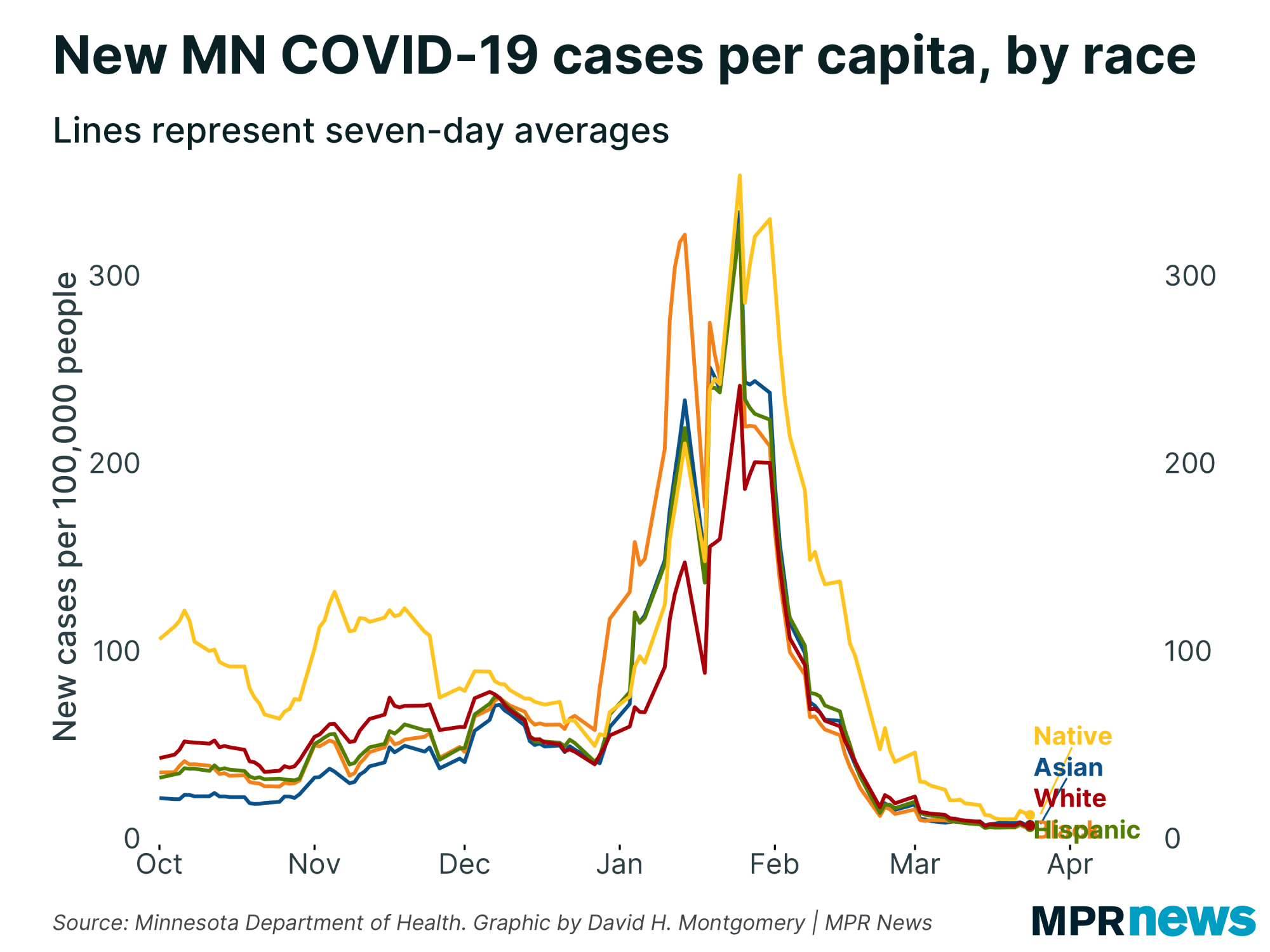
Even as new case counts continue to track well below their late November, early December peaks, the data shows Latino people continue to be hit hard.
Distrust of the government, together with deeply rooted health and economic disparities, have hampered efforts to boost testing among communities of color, officials say, especially among unauthorized immigrants who fear their personal information may be used to deport them.
Officials have acknowledged that distrust by communities of color has been a problem during the pandemic. They’ve offered up some data on vaccinations broken down by race and ethnicity that they’re updating regularly.
Correction (April 14, 2020): An earlier version of this article incorrectly cited small figures for the number of new first vaccine doses that have been administered in recent weeks.
COVID-19 in Minnesota
Data in these graphs are based on the Minnesota Department of Health's cumulative totals released at 11 a.m. daily. You can find more detailed statistics on COVID-19 at the Health Department website.
Top headlines
What you need to know about Minnesota's J&J COVID vaccine pause: Federal authorities are investigating blood clots in six women who got the shot. While the side effects appear to be exceedingly rare, state officials say they are pausing use of the Johnson & Johnson COVID-19 vaccine in an abundance of caution.
COVID vaccine brings hope as Ramadan begins: After a long, challenging year, the availability of a COVID-19 vaccine has brought hope to many in Minnesota and around the globe. Islamic leaders pushed to get the vaccine to as many Muslims as possible before the start of Ramadan, with vaccination clinics planned at mosques in the Twin Cities, Rochester and St. Cloud.


